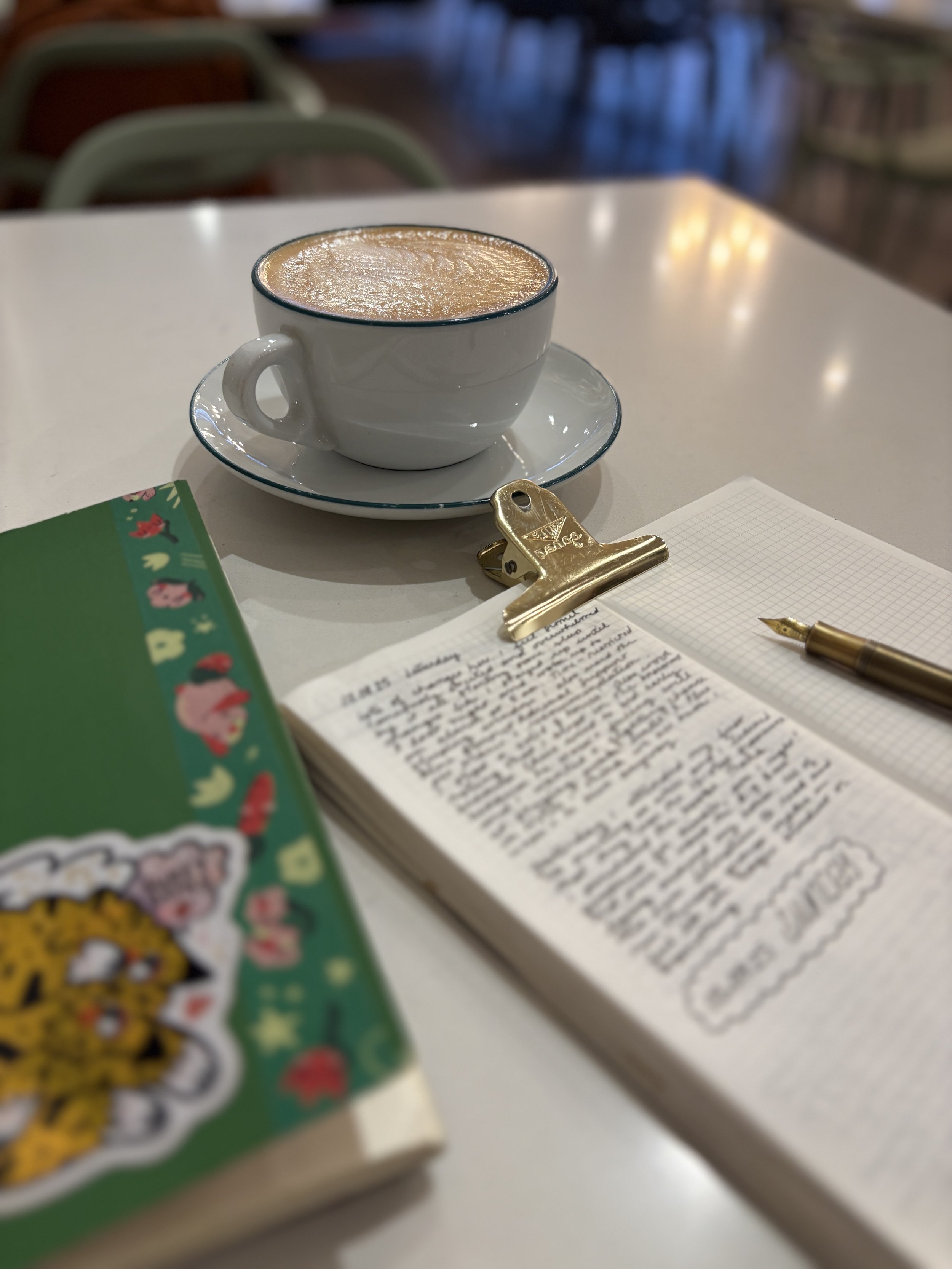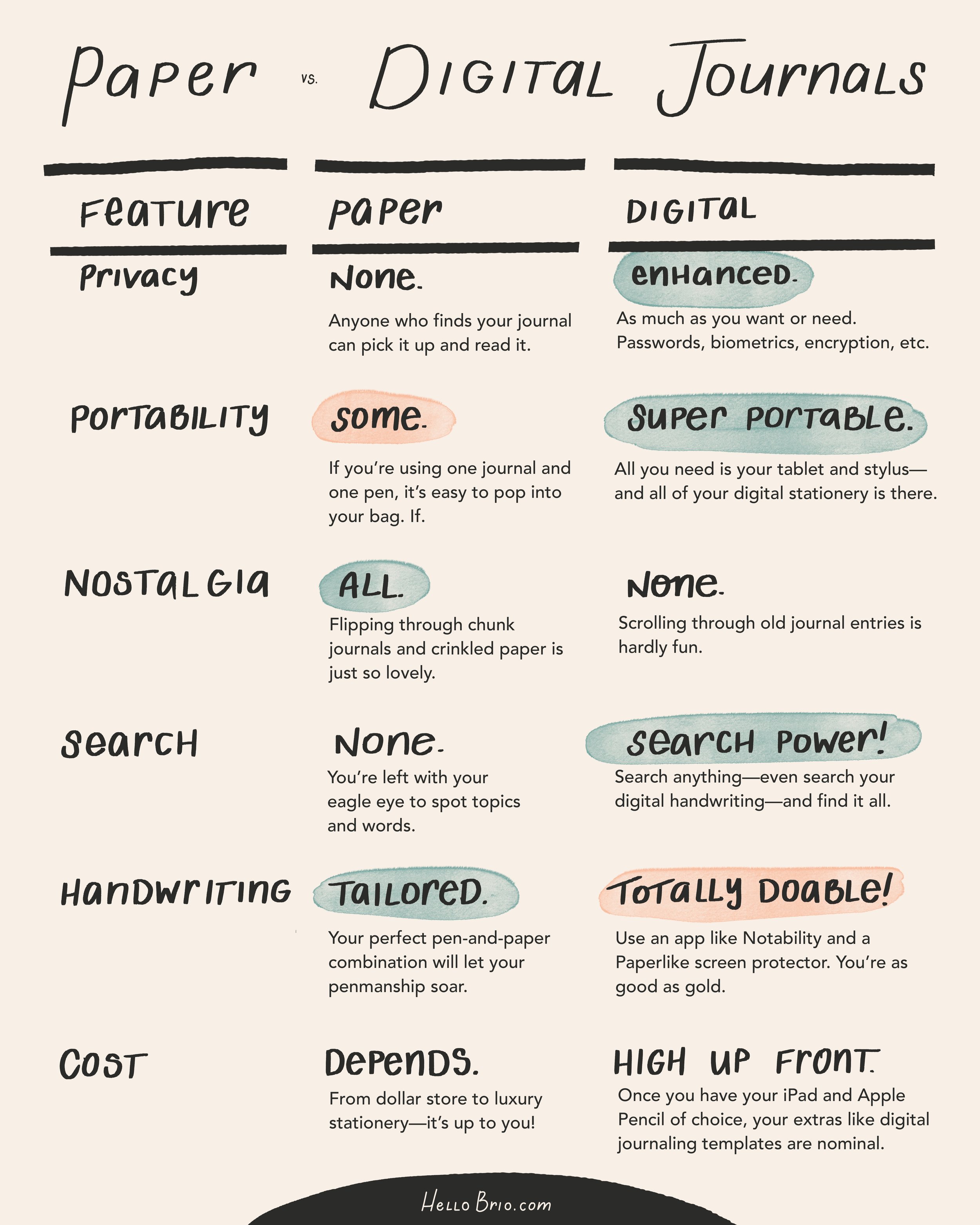Digital vs. Paper Journaling: Which one is for you?
The power of journaling
If you’re here, chances are you know how important journaling can be for self-awareness, decision-making, and memory keeping. By writing down your thoughts day to day, you can start to untangle the thoughts swirling in your head and experience personal growth and clarity. But which is better—digital or paper journaling?
Journaling isn’t just for the dear diary variety anymore, either. Many self-help gurus and mental health experts tout the benefits of journaling. I’m seeing a more and more diverse group of people who keep a journal these days, and I love it!
But ok—say you’re completely new to journaling. Should you go fully digital? There are so many apps available for you to type away at your thoughts—plus most of us are probably faster typers than we are at writing. And let’s not forget that digital journaling can also mean using a handwriting app like Notability and an Apple Pencil on your iPad. So many options.
Or… should you use the time-trusted method of putting pen to paper? There’s nothing quite like a new notebook and leafing through the crinkly pages of your past. Stationery stores bring so much joy, as do the myriad of pen and highlighter options.
If you’re like me and have been journaling for decades, can you switch it up? Can you switch to digital journaling or visa versa?
Spoiler alert: it all depends on your lifestyle, what you prefer, and what may work for you in the moment. The good news is that I’m here to tell you that you can do BOTH. I keep both a paper journal and a digital journal, have been for several years, and I love both for different reasons.
In this post, I’ll walk you through the ins and outs of digital journaling, the timeless charm of traditional/analog journaling, and how to find your perfect fit.
Digital journaling: Embracing technology
First thing’s first. In case you missed it above, digital journaling can be typed OR handwritten. (I mostly do the latter, unless I really need to go full steam ahead with rapid fire journaling, since I can type way faster than I write.)
Digital journaling can be done in any myriad of apps… basically any app that takes down text.
Apple Notes: Want to do something totally weightless and part of the tech you already use? Use Apple Notes, your iPhone’s default note-taking app. This means you can journal on-the-go, even offline, and it will sync with your other Apple products. And because Apple Notes works so well for handwriting, you can also choose to write with your iPad and Apple Pencil, if you so choose.
Apple’s new(ish) Journal app: I have to admit… as much as I’m a tech and journaling person, I have not used Apple’s Journal app. It seems nice enough, but I’m so fully ingrained to the other apps I use.
Day One: Day One is my preferred typed journaling app! I’ve been using it since 2012 and love the experience. It provides extra security and decent prompts and for a small price, you can access their premium features like syncing across unlimited devices, unlimited journals, and adding videos and audio recordings.
Notability: This is my bread-and-butter handwritten note-taking app and digital journal! I love the experience so much that I created my own digital journaling and digital planning templates. You can also check out other similar apps—which are PDF-editing apps at their core—like Goodnotes.
The benefits of digital journaling? Here are some highlights from this in-depth post about the benefits of digital journaling with Notability:
Security and privacy: Password protection. Biometrics. Encryption. This might be the most important aspect for you, hands down. No longer will you have your journals read by your spouse or kids or whomever else. (My Notability is already password protected through my FaceID login to my iPad, and then my journaling section of that app is password protected again.)
Searchability: Want to find all the entries where you wrote about a specific person or topic? Done. (I use this to look for patterns or to try to solve a problem.)
Portability: Journal on your computer but want to access it on your phone when you’re out? Easy peasy. Also, if you have your device where you do your journaling, you’ll always have access to your journal… and all of your prior digital journals… without breaking your back. (I pretty much always have my iPad on me; I can write anytime [even in the dark], and I can reference any journal from before because I’ve scanned in my old paper journals.)
Limitless: With apps like Notability, you can access to pens and highlighters that are any color of the rainbow. No longer will you have to tote around marker binders the size of a small suitcase. Plus, you have an unlimited number of pages without buying a new notebook. (Me, I created my own templates and then I also sell them to other digital journaling enthusiasts. Bonus!) Segue to…
Sustainability: Well okay… tech devices aren’t very sustainable at all, but as long as you’re using your phone/tablet/computer to its full extent and aren’t buying all the things all the time, then at least you’re not using a ton of paper and plastic for stationery hauls. (Sometimes when I have an itch to buy new stationery, I will switch to my iPad for a while to give myself a dopamine hit from the novelty aspect.)
You can save money: This one’s a “sort of,” obviously, because tech is expensive. But when a quality yearly planner runs at $40 and pre-designed blank templates run at a quarter of that price, and you can use them over and over, you’ll end up saving money in the long run. (Unless you’re also a stationery addict anyway, and in that case I highly recommend starting a side gig like I did to support your habit )
Erasing and editing: This may be a bummer for some, but I love being able to erase a wayward handwritten mark or a really messily written word. Plus you can go back and edit an entry if you really want. (Perfectionists unite.)
Different types of media: It’s so easy to drop in photos and screenshots into your digital journal. Plus, you can add videos, audio clips, PDFs, and other digital media that your chosen app accepts. In a paper journal, you’d have to print out photos and such, which adds a lot of overhead for time and equipment needed to do so.
Okay. So I know you paper enthusiasts are out there being like, “but… Jenny… paper!” I get it. I totally get it. Back in September of 2024 I switched back to an analog solution for most of my planning and journaling, because I want to model analog behavior for my kids. (If Mommy is on her iPad all the time, kiddos want to be on their iPads all the time.)
Paper journaling: The timeless charm
Analog, or paper, journaling is great. The tactile experience of writing by hand and then flipping through your used pages is unparalleled. Scrolling through pages of digital entries will never be the same as holding a chonked out book in your hands.
Here are some benefits of traditional analog journaling:
Intentionality and mindfulness: When it’s you and your journal, that’s all you need. A paper journal allows you to focus on the task at hand and put all distracting tech away. For me, this ends up being the most important aspect of journaling on paper. I’m in a UX Design career, so my job involves staring at screens all day. Taking breaks throughout the day to journal—and taking entire days away from screens on the weekends—gives me a chance to refresh my brain and detox dopamine while I interact with my analog journal.
Tactile writing: There’s a level of bliss that happens when you find the right pen-and-paper combination that makes your heart sing. Sure, there are amazing screen protectors that help make writing on a glass iPad screen more like paper, but it’s still a plastic stylus tip on a piece of glass. My ideal paper-and-pen combo is Tomoe River Paper and a fountain pen. There’s also something about pen-on-paper writing that forces you to slow down and watch as the ink spills onto the page, taking up physical space.
Cover personalization: While you can personalize your digital journals to a degree, you can take analog journal covers to the next level by decorating them with stickers, PET tape, washi, and more. Back in my Leuchtturm days, I found so much joy in selecting the best vinyl stickers for my covers. And in terms of top-of-the-line leather or faux-leather covers, there are so many options. This is part of the reason why I love the Travelers Notebook system.
Ephemera: Ephemera, if you’re new to this world, is a fancy word for “stuff you can paste in your journal.” Zip yourself back to grade school and get a tactile rush when you find a cool piece of something that you want to include in your journal… you can bust out your glue stick and scissors and go to town. In fact, there’s a whole movement called junk journaling—look it up! My experience with ephemera tends to be more minimal, but for example today I got a tax form in an envelope with the cutest bunny stamp… so now my journal will house this cancelled stamp forever and ever. In a way, too, the process of identifying and collecting ephemera is like a mini gratitude practice: it keeps me alert to my surroundings, and I get excited when I find something that I want to keep in my journal.
All the stationery: Okay, fine, you got me. Stationery is too fun. Stickers, pens, markers, highlighters, washi tape, paper clips, rulers, stencils… the list is nearly endless. (It’s possible and very easy to overdo it, which is why I try to keep my stationery collection to a minimum, but as long as you’re mindful and stay within a budget you set for yourself, your process for collecting stationery can be mindful and fun. Speaking of which, I actually need to organize and declutter my stationery… but I digress.)
Comparing both types of journaling: Finding your perfect fit
Visual person? Here’s a table to help you make a decision on which journaling style is the best for you.
So which journaling option is best for you?
At the end of the day, the best journaling method is the one that works for you. Whether you embrace the nostalgic charm of paper journaling or the modern convenience of digital journaling—or, like me, enjoy both—your journaling practice should fit seamlessly into your lifestyle.
If you love the feel of pen on paper and the mindful experience of slowing down to write, a traditional journal might be your best bet. If you need the flexibility of a searchable, secure, and portable system, digital journaling is a game-changer. And if you can’t decide? You don’t have to! Mixing both methods allows you to enjoy the benefits of each.
So experiment, explore, and find what sparks joy for you. No matter which path you take, the most important thing is simply to start—your thoughts, memories, and ideas deserve a space to be captured and cherished. Happy journaling!






